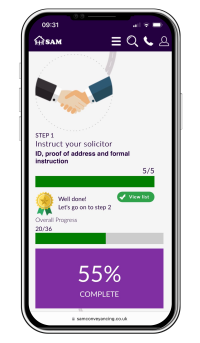When you're buying a home, there is always the possibility that there may be a right of way over some part of your land. Your solicitor finds out whether this is the case when they investigate the title of your property during the
legal enquiries stage of the
conveyancing process.
The article which follows looks at rights of way and considers the following:
Can you walk through private land?
In terms of land, a public right of way through private land is:
"...the legal right, established by usage or grant, to pass along a specific route through grounds or property belonging to another."
Rights of way are one of the most common types of
easements which often provide access rights to owners of adjoining lands. However, public right of way through private land can also be given to the general public (known as the right to roam) if:
- The land is designated as 'open access' - such as mountains, moors, heaths and downs.
- The landowner has given permission for access ('permissive access') via a permissive path.
- There is a local tradition of access.
Additionally public rights of way exist across many types of privately owned land, in the form of footpaths, bridleways and byways. Landowners must ensure they do not obstruct or interfere with these public rights.
Once your conveyancer has received the
contract pack from the vendor's conveyancer, they examine the Title Deeds (or
Office Copy Entries) in particular, as well as the
Property Information Form TA6, to see if there are any references. If there are, your solicitor will brief you about their extent and what the legal and other implications are.
| Download your FREE Pre-Exchange Checklist
You'll put yourself in the best position to advance through legal enquiries if you download and complete your Pre-Exchange Checklist.
Reduce the chance of missing something by downloading your FREE Pre-Exchange Checklist - Created by Solicitors |
How are rights of way created in England and Wales?
They are created in the same way as easements. In terms of permissive access, the landowner can either reach a formal agreement with the local council or may decide to publicise its availability in a less formal manner (for example by displaying signs).
To expand on this further, new public rights of way (including footpaths, bridleways and restricted byways) can be created by the following means (please note that for some of these, if you have a right over your property, you might have to pay to maintain it):
A landowner can expressly dedicate a footpath, bridleway or restricted byway as a public right of way. Additionally, if the public use the conduit for at least 20 years unchallenged then this may give rise to a presumption of dedication under
S31 of the Highways Act 1980.
NB a conduit created by an express dedication is
not automatically maintainable at the public expense.
A local authority can make an agreement (known as a public park creation agreement) with a relevant landowner to create a footpath or bridleway over land in their area, under
S25 of the Highways Act 1980. They only have to consult other local authorities in whose area the path will be; they don't have to consult the public, for example. They have to advertise the agreement in the local press and the public then have to maintain it.
A parish council can make an agreement under
S30 of the Highways Act 1980 with a relevant landowner to create a footpath, bridleway or restricted byway over land in their area and they don't have to consult, although the path is
not automatically maintainable at the public expense.
A local authority (district or county council or unitary authority) can make an order to create a footpath or bridleway over land in their area under
S26 of the Highways Act 1980. It can confirm its order and make the path if there are no objections; if there are then an inspector from the Planning Inspectorate must arbitrate.
A county council or unitary authority can declare a street to be a
highway maintainable at the public expense under
S228 of the Highways Act 1980, as long as the street works authority carries out work appropriate to the conduit along its route (i.e. if it's a potential bridleway, the authority cuts the grass). The street owner can object at the proposal stage and can take the case to a magistrates' court to arbitrate. If the county council win, the street is maintainable at the public expense.
Where are public rights of way in England and Wales listed?
In England and Wales, rights of way only exist where they are so designated (or are able to be designated if not already).
In most of England and Wales they are shown on definitive maps. The highway authority (normally the county council or unitary authority) has a statutory duty to maintain a definitive map, though in national parks the National Park Authority usually maintains the map. London and the City of London however do not have to maintain definitive maps.
If you wish to check whether there is a public right of way through private land, you should therefore consult the relevant local authority to view its definitive map if outside London, or for within London you should visit the
Rambler's Association website, where you can use their postcode search and other tools.
What are the public footpath rules on private land?
|
- The public has the conditional right to walk in certain areas of the English and Welsh countryside: principally downland, moorland, heathland and coastal land.
- This was enshrined in the Countryside and Rights of Way Act 2000 and is in addition to rights of way, and does not extend to:
- Access land may be closed for up to 28 days per year, whereas rights of way must remain open at all times, except in exceptional circumstances with special permission of the local authority.
| - This is also known as a permitted path or concessionary path
- The previous landowner has allowed its use
- walkers
- horse-riders
- cyclists
- The path may not be on the definitive map of public rights of way, but that does not prevent it from already being a public path for any or all of the categories mentioned above. For instance, it might be a historic route fallen into disuse or it might have been used for twenty years 'as of right' by the public, in both cases being a public right of way which is not yet shown on the map.
- A permissive path is often closed on a specified calendar day each year (lawful only if it is not already a public right of way of some description), and clearly signed (i.e. a signpost or waymark) as permissive. The act of closing or signing it ensures that any future use of it does not count towards the 20 years use 'as of right' (which is needed to establish its public status).
|
Can this affect your property price?
Yes, this can affect your property price, particularly if there are many of them. It might, for example decrease the number of possible future building sites and this might be unattractive to future buyers.
You should also pay close attention to a situation where the right is not currently in use but may become so in the future for the same reasons.










